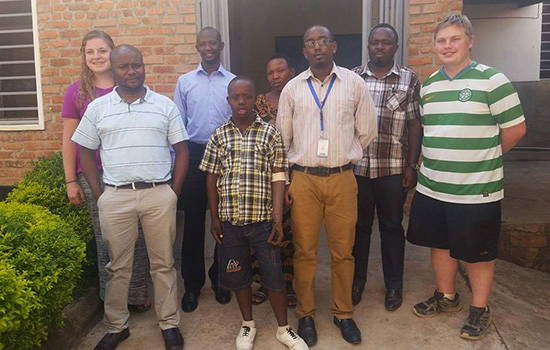Students provide 3D-printed arm to teen in Rwanda
Project helps teen with day-to-day tasks and becomes a foundation for business opportunities in region
Provided
Family and friends from the Children Might Foundation worked with RIT engineering students Laura Alderfer, far left, and Ken Postel, far right, to bring Eric, center, a 3D-printed prosthetic arm to him at his family’s home in Rwanda.
When Eric first saw the prosthetic arm that two RIT engineering students designed, he was nervous about touching it, let alone wearing it. Family and friends from his village in Rwamagana, in eastern Rwanda, gathered to be there as he received the new hand, and they encouraged him to try it himself.
Once he did, it seemed to change everything, said Laura Alderfer. She and Ken Postel, both undergraduate students in RIT’s Kate Gleason College of Engineering, traveled to Rwanda to deliver the arm after spending the fall semester designing, printing and testing it for the 19-year-old boy. The two students had experience with international travel after previous work as part of Engineering World Health. The campus student organization had undertaken several international trips to Haiti, Guatemala and Rwanda to work in hospitals and other community organizations repairing and upgrading medical equipment.
Alderfer kept in contact with hospital administrators and the director of the Children Might Foundation when she worked in Rwanda in 2014. Wanting to return to the country, she inquired about projects and learned about children in need of prosthetic devices. Eric was one of the teens at the top of the list. Given just measurements of the teen’s limb and a brief description of what activities he wanted to be able to do, the two students built a device that could work for him. There would be some challenges both at home and abroad—from learning about 3D printing to improvising with tools on site—but the surprises also proved to be inspiring, said Alderfer.
“I never 3D printed anything prior to this school year. I have experience in bio-mechanics, but the 3D printing realm, CAD, I’m not an expert. Not even a novice,” she said laughing. The fifth-year biomedical engineering student and member of RIT’s women’s crew team met Postel the year prior as they were preparing to go to Guatemala with Engineering World Health. She asked him to teach her about 3D printing.
“Then her quick follow up was, we’re going to deliver it, too,” said Postel, a fifth-year industrial and system engineering student from Cleveland, who intends to go into the 3D-printing field after graduation this May. Throughout the fall semester, the two worked on different designs and came up with a prosthetic sized for a teen. The grasping mechanism would allow him to open a bottle of water, cut food, use a broom, carry firewood—activities often taken for granted. The new hand would not replace fine motor skills but could help completing different rudimentary tasks. The students also had to consider environment, long-term use and access to repair and services.
“It’s so important to understand your design context. You have to understand environments and situations and then design based on that,” said Alderfer, who is from Sellersville, Pa., and who will graduate in May. Having contacts within the country also was a benefit, and the Children Might Foundation was a critical component because they knew Eric’s family. Although a caseworker from the agency came with the students acting as translator and guide, they were able to learn and use different phrases in Kinyarwanda, the regional language.
“He translated flawlessly back and forth and he knew the cultural practices, but it went a long way to be able to go into the house and greet the mom and kids in their own language. I can’t have a conversation with them, but a smile and ‘good morning’ goes a long way,” said Alderfer.
The good will was necessary as the students expected their visit in late January to be 1 to 2 days; it turned into several. Modifications to their design were necessary and the power tool they brought with them was damaged. They had to improvise with a pocket knife, screwdriver, heat gun and a pair of scissors.
“It’s not like we couldn’t get the job done, it just took us a bit longer,” said Postel.
And the project became bigger than delivering the hand to Eric, when their design drew the interest of faculty-researchers at the University of Rwanda and the International Society of Prosthetics and Orthotics (ISPO). Representatives from each organization met with the students. Although skeptical about the socket the students used for the prosthetic, they were interested in the hand section and the costs associated with developing the overall design. The ISPO offered to make Eric a professionally-fit socket.
“The university is developing their own center for biomedical excellence, and they want to try to incorporate this into their new center as research and possibly as a funding resource,” said Postel.
Both students want to return to Rwanda, either to continue the current work or to help further the product development process because there is a great need for these services.
“I want to remain involved,” said Alderfer. “I want to travel back to Rwanda, but in a way that will help serve them and not just my personal interests. I could help train others and they could do so much with 3D-printed prosthetics.”
More information about the students’ travel can be found in an online video and through Alderfer’s blog site.











